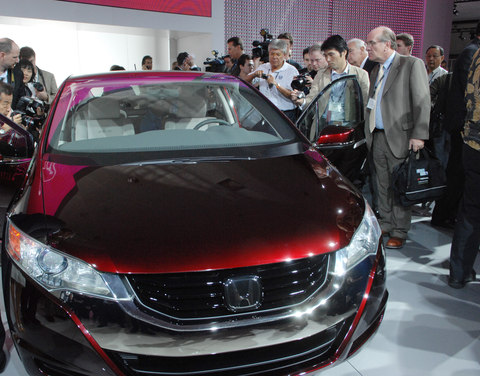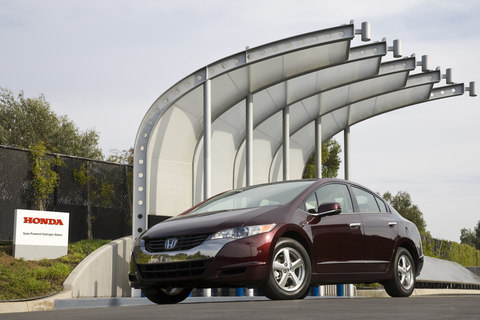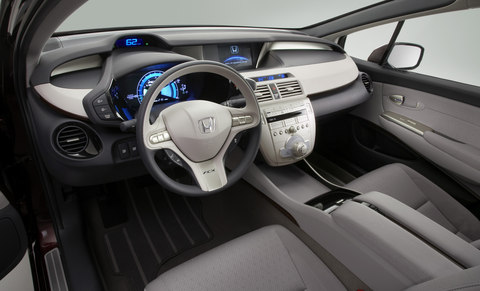11/14/2007 – LOS ANGELES

Honda today unveiled the FCX Clarity fuel cell vehicle at the Los Angeles Auto Show, announcing plans to begin limited retail marketing of the vehicle in summer 2008.
The FCX Clarity is a next-generation, zero-emissions, hydrogen-powered fuel cell vehicle based on the entirely-new Honda V Flow fuel cell platform, and powered by the highly compact, efficient and powerful Honda V Flow fuel cell stack. Featuring tremendous improvements to driving range, power, weight and efficiency – and boasting a low-slung, dynamic and sophisticated appearance, previously unachievable in a fuel cell vehicle – the FCX Clarity marks the significant progress Honda continues to make in advancing the real-world performance and appeal of the hydrogen-powered fuel cell car.
“The FCX Clarity is a shining symbol of the progress we’ve made with fuel cell vehicles and of our belief in the promise of this technology,” said Tetsuo Iwamura, American Honda president and CEO. “Step by step, with continuous effort, commitment and focus, we are working to overcome obstacles to the mass-market potential of zero-emissions hydrogen fuel cell automobiles.”
American Honda plans to lease the FCX Clarity to a limited number of retail consumers in Southern California with the first deliveries taking place in summer 2008.
Full details of the lease program will be set closer to launch, but current plans call for a three-year lease term with a price of $600 per month, including maintenance and collision insurance. American Honda is also developing a service infrastructure that provides customers with the best balance of convenience and the highest quality of service. When the FCX Clarity requires periodic maintenance, customers will simply schedule a visit with their local Honda dealer. American Honda will transport the vehicle to their fuel cell service facility, located in the greater Los Angeles area, where all required work will be performed. At the completion of the work, the customer will pick up their car from the dealer.
How It Works
The FCX Clarity utilizes Honda’s V Flow stack in combination with a new compact and efficient lithium ion battery pack and a single hydrogen storage tank to power the vehicle’s electric drive motor. The fuel cell stack operates as the vehicle’s main power source. Hydrogen combines with atmospheric oxygen in the fuel cell stack, where chemical energy from the reaction is converted into electric power used to propel the vehicle. Additional energy captured through regenerative braking and deceleration is stored in the lithium ion battery pack, and used to supplement power from the fuel cell, when needed. The vehicle’s only emission is water.
Honda V Flow Fuel Cell Platform
The FCX Clarity’s revolutionary new V Flow platform packages the ultra-compact, lightweight and powerful Honda V Flow fuel cell stack (65 percent smaller than the previous Honda FC stack) in the vehicle’s center tunnel, between the two front seats. Taking advantage of a completely new cell configuration, the vertically-oriented stack achieves an output of 100 kilowatts (kW) (versus 86kW in the current Honda FC stack) with a 50 percent increase in output density by volume (67 percent by mass). Its compact size allows for a more spacious interior and more efficient packaging of other powertrain components, which would otherwise be unattainable in a sleek, low-slung sedan.
The FCX Clarity boasts numerous other significant advances in the performance and packaging of Honda fuel cell technology, compared to the current-generation FCX. These include1:
- a 20-percent increase in fuel economy – to the approximate equivalent of 68 mpg2 combined fuel economy (about 2-3 times the fuel economy of a gasoline-powered car, and 1.5 times that of a gasoline-electric hybrid vehicle, of comparable size and performance);
- a 30-percent increase in vehicle range – to 270 miles;
- a 25-percent improvement in power-to-weight ratio, in part from an approximate 400-pound reduction in the fuel cell powertrain weight, for superior performance and efficiency despite a substantial increase in overall vehicle size;
- a 45-percent reduction in the size of the fuel cell powertrain – nearly equivalent, in terms of volume, to a modern gas-electric hybrid powertrain;
- an advanced new lithium-ion battery pack that is 40 percent lighter and 50 percent smaller than the current-generation FCX’s ultra-capacitor; and
- a single 5,000-psi hydrogen storage tank with 10 percent additional hydrogen capacity than the previous model.
FCX Clarity Design
More than just a fuel cell vehicle – the FCX Clarity speaks to Honda’s vision of the future of automobile design and performance freed from the constraints of conventional powertrain technologies. The FCX Clarity’s four-door sedan platform features a short-nose body and spacious cabin with comfortable accommodations for four people and their luggage. Major powertrain components – including the electric motor, fuel cell stack, battery pack and hydrogen tank – have been made more compact and are distributed throughout the vehicle to further optimize space, comfort and total vehicle performance.
Advanced Materials and Components
In keeping with its theme as an environmentally-advanced automobile, the FCX Clarity features seat upholstery and door linings made from Honda Bio-Fabric – a newly-developed, plant-based material that offers CO2 reductions as an alternative to traditional interior materials, along with outstanding durability and resistance to wear, stretching, and damage from sunlight.
Designed to appeal to forward-thinking customers seeking the ultimate in zero-emissions, alternative-fuel vehicle performance, the FCX Clarity is also equipped with a full compliment of advanced safety, comfort and convenience features, including a state-of-the-art navigation system with hydrogen station locations, backup camera, premium audio, climate-controlled seats and Bluetooth™ connectivity.
Other improvements, such as shift-by-wire, electric power steering (EPS), and a newly-designed instrument panel with an easy-to-read hydrogen fuel-consumption display, further improve its customer appeal and ease of operation.
CO2 Emissions
The FCX Clarity’s only emission is water. Carbon Dioxide (CO2) emissions come only from the production of hydrogen, which varies by source; however, well-to-wheel CO2 emissions using hydrogen reformed from natural gas – the most widely used method of production today – are less than half that of a conventional gasoline vehicle. With the production of hydrogen from water by electrolysis, CO2 emissions can be further reduced and ultimately approach zero if the electricity used for electrolysis is generated using solar, wind, water or nuclear power.
Honda has developed its own solar cells, with half of the CO2 emissions in the production stage compared to conventional crystalline silicon cells; and has begun mass-production and retail sales of this technology in Japan for both commercial and residential use.
Fuel Cell Leadership
Based on its vision of, “Blue Skies for our Children”, Honda has worked for forty years at reducing the environmental impact of the automobile, including efforts to reduce emissions, boost fuel efficiency and, now, many industry-leading efforts to advance the hydrogen fuel cell vehicle – a technology and fuel that Honda believes may hold the ultimate promise for a clean and sustainable transportation future. Honda’s pioneering achievements in this area include the first EPA and CARB certification of a fuel cell vehicle (2002); the first lease of a fuel cell vehicle (2002); the first fuel cell vehicle to receive an EPA fuel economy rating (2002); the first cold-weather customer (2004); the first and still only individual retail customers (2005, 2007); and the first and still only fuel cell vehicle to be eligible for a federal tax credit.
About Honda
Honda is America’s most fuel-efficient car company and a leader in the development of leading-edge technologies to improve fuel efficiency and reduce CO2 emissions, including advanced gasoline engines, gasoline-electric hybrids, natural gas-powered engines, and hydrogen fuel cells. Founded in Japan in 1948, Honda began operations in the U.S. in 1959 with the establishment of American Honda Motor Co., Inc., Honda’s first overseas subsidiary. Honda began U.S. production3 of motorcycles in 1979 and automobiles in 1982. The company has invested more than $9 billion in its North American operations with 14 major manufacturing facilities, employment of more than 35,000 associates, and annual purchases of more than $17.6 billion in parts and materials from suppliers in North America.
A consumer Web site for the FCX is available at fcx.honda.com. Media information, high-resolution images and video of the FCX Clarity (and other Honda vehicles) is available at www.hondanews.com. More information about Honda’s environmental initiatives and products can be found in the company’s annual North American Environmental Report which can be downloaded at www.honda.com.
1 Specifications may change prior to the certification and sales of production units.
2 Honda in-house calculation
3 Using domestic and globally sourced parts
###

Source:
Hondanews.com



Pingback: Wind Generation